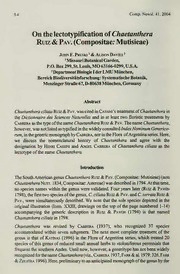
On the lectotypification of Chaetanthera Ruiz & Pav. (Compositae: Mutisieae) PDF
Preview On the lectotypification of Chaetanthera Ruiz & Pav. (Compositae: Mutisieae)
54 Comp. Newsl.41, 2004 On thelectotypification ofChaetanthera & Ruiz Pav. (Compositae: Mutisieae) & JohnF.Pruski' AlisonDavies2 1MissouriBotanicalGarden, MO P.O.Box299,StLouis, 63166-0299,U.S.A LMU 2DepartmentBiologieIder Munchen, BereichBiodiversitatsforschung:SystematischeBotanik, MenzingerStrafie67,D-80638Munchen,Germany Abstract & ChaetantheraciliataRuiz Pav.wascitedinCassdmi'streatmentofChaetantherain theDictionnaire des Sciences Naturelles and in at least two florisric treatments by CabreraasthetypeofthenameChaetantheraRuiz&Pav.ThenameChaetanthera, however,wasnotlistedastypifiedinthewidelyconsultedIndexNominumGenerico- rum,inthegenericmonographbyCabrera,norintheFlora ofArgentinaseries.Here, we discuss the nomenclatural history of Chaetanthera and agree with the designation by Henri Cassini and Angel Cabrera of Chaetanthera ciliata as the lectotype ofthename Chaetanthera. Introduction & TheSouthAmericangenusChaetantheraRuiz Pav.(Compositae:Mutisieae)(non ChaetantheraNun. 1834,Compositae:Astereae)wasdescribedin1794.Atthattime, no species names within the genus werevalidated. Fouryears later(Ruiz&Pavon & C & 1798),thefirsttwospeciesofthegenus,C.ciliataRuiz Pav.and serrataRuiz Pav., were simultaneously described. We note thatthe sole species depicted in the original illustration (Icon. XXIII, drawings on the top ofthepage numbered 1-14) accompanying the generic description in Ruiz & Pavon (1794) is that named Chaetantheraciliatain 1798. Chaetanthera was revised by Cabrera (1937), who recognized 37 species accommodated within seven subgenera. The next most complete treatment ofthe genus is that ofKaunas (1996) in the Flora ofArgentina series, which treated 20 species ofthis genus ofreducedsmall annual herbs to stoloniferousperennials that frequentthesouthernAndes. Untilnow,however, ageneritypehasnotbeenwidely & recognizedforthenameChaetanthera(viz.,Cabrera 1937,Farr al. 1979:326,Farr 6Zijlstra 1996).Here,preliminarytoananticipatedmonographofthegenusbythe Comp. Newsl.41,2004 55 secondauthor,wewishtoformallyrecognizethecitationsby(1)HenriCassiniinhis treatmentofChaetantheraintheDictionnairedesSciencesNaturelles(1817:53)and (2)AngelCabrera(1971:311,1978:627)intheflorasofPatagoniaandJujuyProvince ofChaetantheraciliataRuiz&Pav. asthelectotypeofthename Chaetanthera. The two original species ofChaetanthera described by Ruiz & Pavon have been variouslytreatedasbelongingto: (1) differentgenera(e.g. Don 1830); (2) different infrageneric taxaofChaetanthera (e.g. Cabrera 1937); orto the same infrageneric taxonofChaetanthera(e.g.Lessing 1832,Candolle 1838). Don(1830:234-236) removedChaetantheraserratatounispecificProseliaD.Don & leavingC.ciliataRuiz Pav.andC.spinulosaCass,(namedin1826)astheonlytwo names (at that time) within Chaetanthera. That the two original species belong to different groups was more or less echoed 100 years laterby Cabrera (1937), who treatedChaetantheraserratawithinChaetantherasubg.Proselia(D.Don)Cabrera and Chaetanthera ciliata within Chaetanthera subg. Chaetanthera. Neither the taxonomictreatmentsbyDon(1830)norCabrera(1937),however,technicallyeffected nomenclatural lectotypification ofthe name Chaetanthera. Similarly, Bentham & Hooker(1873:496)notedthatC. serratawasthesolespeciesattributedtoProselia, butneitherdidtheyeffectlectotypification ofChaetanthera. Two yearsafterDon describedProselia, Lessing (1832) reducedDon's genus into synonymy of Chaetanthera. Specifically, Lessing (1832: 113) treated both Chaetanthera ciliata Ruiz & Pav. and C. serrata Ruiz & Pav. as members of Chaetanthera subg. Chaetanthera. Candolle (1838: 30-31) followed suite, albeit employingtherankofsections,treatingthetwooriginalRuiz&Pavonspecieswithin Chaetanthera sect. "Euchaetanthera." Cassini (1817: 53) said "la chaetanthere ciliee devra toujours, selon nous, etre consideree comme levrai type du genre." Itcouldbe debatedwhetherthis entryof Cassinieffectslectotypification,butneverthelessCassiniclearlynotedthatC. ciliata was generallypreferredasbeing the"true" type. However,thename Chaetanthera was directly citedby Cabrera (1971: 311, 1978: 627) as typifiedby Chaetanthera ciliataRuiz&Pav.,albeitnotlistedsubsequentlyintheprintedandwebversionsof theessentialgeneralreferenceIndexNominum Genericorum (Farr&al. 1979: 326, Farr&Zijlstra 1996).Additionally,inusingthe"doctrineofresidues"(notpartofthe ICBN,butneverthelessoftenausefulruleofthumb)asaguide,wecanunofficially C & inferthatDon'sdescriptionofProselialeft ciliataasthesoleoriginalRuiz Pav. name in Chaetanthera, thus unofficially as the type. Moreover, and as also noted byCabrera (1937: 93-94), the fact that Chaetanthera ciliata was the species originally illustrated by Ruiz & Pavon (1794) lends credence to treating the name Chaetanthera asbeing circumscribedwith C. ciliata as thetypeas donebyCassini (1817)andCABRERA(1971, 1978). , 56 Comp. Newsl. 41,2004 Conclusion Two centuriesofspecialists workingwiththis oddgroup ofsmall southernAndean Composites have taken C. ciliata as the type of the name Chaetanthera. Chaetanthera ciliata, however, is not listed as the type of Chaetanthera in Index NominumGenericorum(Farretal. 1979,Farr&Zulstra 1996).Thetypificationof the generic name Chaetanthera by C ciliata bears directly upon species assignments to the seven subgeneratreatedbyCabrera (1937),henceourdesireto have the generic name listed as typified by C. ciliata in future editions ofIndex NominumGenericorum. Thus, in accordancewith twocenturies ofworking taxonomic opinion, tomaintain current usage of the long-standing infrageneric species allocations within & Chaetanthera, andtorecognizethatRuiz Pavonillustratedbutonespeciesinthe Prodromus(1794),weagreewiththecitationsofCassini(1817)andCabrera(1971 1978) and recognize Chaetanthera ciliata Ruiz & Pav. as lectotype for the name & ChaetantheraRuiz Pav. Lectotypification ChaetantheraRuiz&Pav.,Fl.Peru.Chil.Prodr. 106.Icon.XXHI. 1794. Lectotype (designated by Cassini 1817: 53, Cabrera 1971: 311, 1978: 627): & ChaetantheraciliataRuiz Pav.,Syst.Veg.Peru.Chile. 190. 1798. Acknowledgements WewouldliketothankKanchiGandhi,LejanaKatinas,andJohnMcNeillfortheir helpandcommentsonearlierdraftsofthisnote. Comp. Newsl.41,2004 57 References Bentham,G.&J.D.Hooker 1873.Compositae.Pp. 163-533.In:GeneraPlantarum, & vol.2,partI.Reeve Co.,London. Cabrera,A.L. 1937.RevisiondelgeneroChaetanthera(Compositae).Rev.Mus.La Plata,Secc.Bot. 1, 1:87-21 +LaminaeI-IV. Cabrera,A.L. 1971.Compositae.In:M.N.Correa(ed.),FloraPatagonica,part7. ColeccionCientificadelINTA,tomo8.BuenosAires,Argentina. Cabrera,A.L. 1978.Compositae.In:A.L.Cabrera(ed.),FloradelaProvinciade Jujuy,RepublicaArgentina,part 10. ColeccionCientificadelINTA,tomo 13, BuenosAires,Argentina. Candolle,AP. de 1838. Prodromussystematis naturalisregnivegetabilis, vol. 7, & partI.Treuttel Wiirtz,Paris. Cassini,H. 1817. Chaetanthera. Pp.53-55.In:F.Cuvier(ed.),DictionnairedesSci- encesNaturelles,ed.2,vol.8:CER-CHI.Levrault,Paris. Don,D. 1830. Descriptions ofthenew generaandspeciesoftheClassCompositae belongingtotheFlorasofPeru,Mexico,andChile. Trans. Linn. Soc. Bot. 16: 160-303. Farr,E. R,Leussink,J. A. & F.A. Stafleu 1979. IndexNominum Genericorum (Plantarum). UtrechtPublishers, TheHague. Farr,E.R&G.Zijlstra(eds.) 1996.IndexNominum Genericorum (Plantarum), web versionposted9 February 1996. IndexNominum Genericorum (ING)- http://rathbun.si.edu/botany/ing/ Katinas,L. 1996.Asteraceae,part4.TribuXII.Mutisieae.Subtribu3.Mutisiinae.In: A.T.Hunzdcer(ed.),FloraFanerogdmicaArgentina29(4):3-40. Lessing, C.F. 1832. Synopsis Generum Compositarum, earumque dispositionis novae tentamen monographiis multarum capensium interjectis. Sumtibus DunckerietHumblouLBerlin. & Ruiz, H. J. Pavon 1794. Florae Peruvianae et Chilensis Prodromus. Sancha, Madrid. & Ruiz,H. J. Pavon 1798. Systema VegetabiliumFloraePeruvianaeet Chilensis. Sancha,Madrid.
